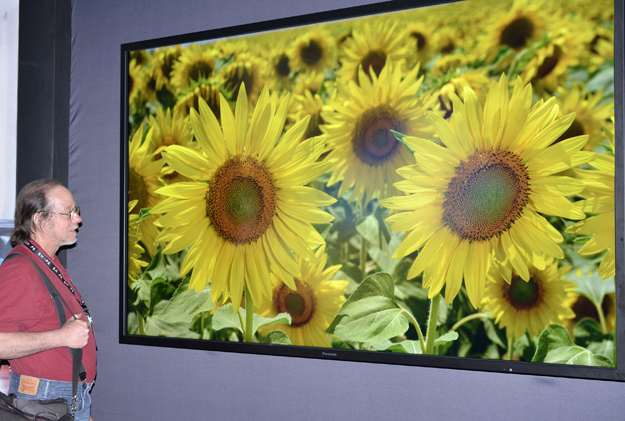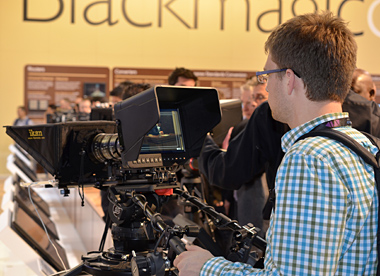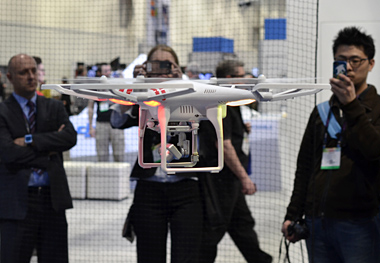NAB 2015 Portends Major Changes In the Air

NAB 2014 photo: Thomas Ingeldew of Long Run Productions gets a close look at Panasonic's TH-98LQ70U 4K display. Note: That is the actual image on the display—it is not simulated.
ALEXANDRIA, VA.—The annual pilgrimage to the southwestern desert is upon us again, and I anticipate much to see at the big show. It turns out that 2015 may be one of the more pivotal years in the broadcast industry, due to the accelerating pace of technology.
Back in 2000 or so, the big theme at the NAB was “convergence,” which at the time meant a future when television and computers would somehow be merged into a new world of television acquisition, management, distribution and consumption. That new world is now all around us, and the results are not necessarily what broadcasters wanted.
For one thing, the merging of television with computer networks led to smartphones and their wireless infrastructure that is quickly consuming the broadcast spectrum broadcasters use for their livelihoods. For another, the expanding capabilities of modern equipment means that there are features built into our gear that we haven’t yet figured out how to use.
That said, this year’s NAB Show stands at a possibly unique turning point for several reasons. Let’s take a look at those reasons.
In the U.S., over-the-air broadcasters currently use the ATSC 1.0 system. This works reasonably well for fixed home reception and an add-on called ATSC-M/H works decently enough for mobile and other challenging reception conditions. However, not all broadcasters use ATSC-M/H, so many broadcasters simply ignore a possible audience of mobile viewers.
Last year saw multiple tests of proposals for an ATSC 3.0 system, all of which have considerably better reception in challenging environments than ATSC-M/H. Furthermore, the proposals for ATSC 3.0 are all compatible with 4K/UHD transmission, which can display video with four times the resolution of today’s HD broadcasts.
Although there is not a final standard for ATSC 2.0 yet, the 2015 NAB Show will have an extensive display of proposed technologies for ATSC 3.0. If you are a broadcaster, you simply have to stop by at least some of these companies and organizations to see what it’s all about. It is where television must go if it is to remain relevant to OTA viewers. An interesting benefit of the current ATSC 3.0 proposals is that they look pretty attractive to international broadcasters as well. In other words, it may be possible in our lifetime to have a single television system that unifies nearly the entire world.

NAB 2014 photo: Adam Knight of Red Element Studios tries out the Blackmagic Studio Camera.
Related ATSC 3.0, yet different, is the push to 4K/UHD resolution. There are a few people out there who say that 4K is a stop-gap and that 8K should be the real destination, as well as some who say that HD is good enough and we can benefit more cheaply by increasing the internal processing of our television systems from 8-bit to 10- or 12-bit processing. Regardless of how this ultimately resolves, 4K televisions are now being sold to the public for prices that are a modest increase over similarly sized HD televisions. Why buy 1,920 x 1,080 when you can get 3,840 x 2,160 for 15-percent more?
In addition to the viewing end, all major camera manufacturers are selling cameras that shoot 4K video, at all quality levels from consumer to film producers. Like the televisions, these cameras (and their associated lenses) sell for a modest premium over the cost of their HD cousins. Considering you buy a camera to last for a few years, it is getting increasingly hard to think about buying an $8,000 HD camera when you can get a similar 4K camera for $9,000. One vice president at a well-known camera manufacturer privately told me that he recommended that his company stop building professional HD cameras and switch to 4K models only.
Talk about convergence between television and computers—this year, you can expect a lot of talk about IP connectivity for video products. You can now buy an entire studio worth of gear that interconnects using IP technology, which has major connotations both good and bad.
On the good side, IP technology is common, cheap, reliable and used by nearly everyone. Its ubiquity means that there are strong standards and many IP network components are as close as your nearest Best Buy and Home Depot stores. The cable for it is common and cheap, and it has lots of conductors that can be used for alternate purposes, such as powering remote devices.
On the other hand, connecting video products via IP means that each device is on a network with an IB address. If that network connects to the public Internet, then there is a possibility that the system can be hacked, tampered with and hijacked. Imagine all the mischief if hackers broke into the video systems at the Olympics or Super Bowl. Or presidential address. Obviously, work needs to be done to make security foolproof when using IP-connected video gear.
How promising is interconnecting components using Cat-6 cable and IP network topology? There’s already demos showing that such a system can be used for uncompressed 4K video, and that’s a LOT of data.

NAB 2014 photo: Many NAB attendees found DJI’s Phantom Vision 2 QuadCopter to be photogenic.
And forgive us journalists for droning on about… drones. Drones for television and film production will be all over at the NAB Show, particularly at the new Aerial Robotics and Drone Pavilion. The new exhibit area is located in the South Upper Hall of the Las Vegas Convention Center. According to the NAB, the Aerial Robotics and Drone Pavilion will feature dozens of aerial robotics companies, a flying cage, a demonstration area with seating and daily sessions.
In the U.S., the Federal Aviation Administration has been slow to allow drones for commercial use. However, the dam holding back the requests has cracked and more organizations are getting approval to fly remote-controlled camera platforms. Some TV news organizations are eager to use drones in their coverage, and production companies increasingly demand drone shots with their interesting camera angles.
All these four things stand a good chance of changing the professional television industry in ways big and small. Some are interesting but minor advances, while others represent a fundamental shift. We’ll know more in a week just what they will mean to the industry.
Get the TV Tech Newsletter
The professional video industry's #1 source for news, trends and product and tech information. Sign up below.
Bob Kovacs is the former Technology Editor for TV Tech and editor of Government Video. He is a long-time video engineer and writer, who now works as a video producer for a government agency. In 2020, Kovacs won several awards as the editor and co-producer of the short film "Rendezvous."

